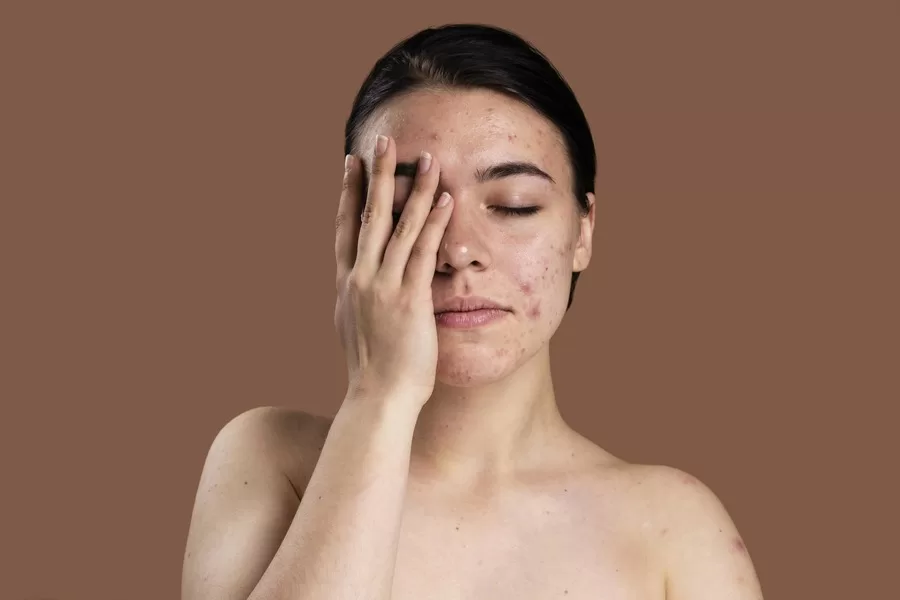
Have you noticed unusual changes in your body or mood? It might be high testosterone, a condition that’s not exclusive to men but prevalent in women as well. What is testosterone and how do you know if it has increased?
Testosterone in Women’s Health
In women, testosterone’s role is multifaceted yet often underappreciated. It is a hormone that helps strengthen and repair muscles, keep bones resilient over time, and fuel the fires of sexual health and desire.
As seasons of life change, so do the levels of testosterone in a woman’s body. This natural ebb, particularly noted during the transition into menopause, might lead to a subtle yet impactful downturn in physical endurance, a slight retreat of bone fortitude, and a cooling of sexual fervor. These are not mere inconveniences but whispers of change, signaling a need for adaptation and understanding.
Nuances of Testosterone Levels for Women
Excess can disrupt the body’s harmony, manifesting in physical symptoms that are out of tune with one’s natural rhythm. Too little, and the melody of well-being might wane, leading to a diminishment of life’s vigor. In these moments, the wisdom of medical guidance shines, helping to tailor a path of balance through lifestyle nuances or medical interventions as needed.
Understanding the nuanced role of testosterone in women’s health is not just about scientific knowledge. It’s about tuning into one’s own body, recognizing the subtle signs of hormonal shifts, and seeking harmony within. It’s about empowered health decisions, fostering a symphony of well-being that plays uniquely for each woman. In this journey, every woman is her own best advocate, exploring the paths of health with curiosity and care, ensuring that her life is lived with a richness and depth that is uniquely her own.
High Testosterone in Women
High testosterone in women isn’t as widely discussed, but it’s quite significant. Normally, it helps in maintaining muscle strength, bone density, and a stable mood. However, when the levels rise, the story changes. You might notice your skin getting oilier or breaking out in acne. Hair could grow in unexpected places, like the face or abdomen. Your periods might become irregular or even take a hiatus. On the physical side, there might be an increase in muscle mass or changes in body shape. Emotionally, you could feel like you’re on a mood swing marathon, experiencing quick shifts in how you feel.
Spotting these changes? It’s important to consult with a healthcare professional. They can perform blood tests to measure your testosterone and help diagnose the issue accurately. Knowing what’s up is the first step in getting things back to normal.
Treatment for High Testosterone Levels
Regarding treatment, there are several paths you might take, depending on the cause. If it’s related to a condition like polycystic ovary syndrome (PCOS), addressing that could help balance your testosterone. Lifestyle changes are also powerful. Integrating more physical activity, adjusting your diet, and managing stress can positively influence your hormone levels. In some cases, medication might be necessary to directly adjust the testosterone or treat symptoms.
It’s also crucial to address the emotional rollercoaster that high testosterone can bring. Finding support through therapy, support groups, or even open conversations with friends and family can provide comfort and strategies for managing the emotional aspects of your condition.
Dealing with high testosterone is a journey of understanding and adapting. With the right information and support, it’s a path that leads to better health and well-being. Stay informed, seek help when needed, and take steps towards balancing your life. Here’s to your health and happiness on this journey!
How to keep testosterone normal?
Experiencing high testosterone levels can be challenging for women, leading to a variety of symptoms that affect health and well-being.
- Foods. Fill your meals with colorful vegetables, fruits, lean proteins, and whole grains. Think of each meal as an opportunity to feed your body with care. Reducing processed foods and sweets can also help maintain a happy, hormone-balanced you.
- Get Moving Joyfully. Dance in your living room, take a brisk walk in the park, or join a local sports team. Find joy in movement, and as you do, you’ll not only help balance your hormones but also boost your mood and self-esteem.
- Explore Gentle Herbs. Herbs are nature’s gift, offering gentle support to our bodies. Sipping on spearmint tea or adding a sprinkle of ground flaxseed to your dishes are examples of how you can incorporate these natural wonders into your life. Always consult with a healthcare professional to find the best herbal allies for your journey.
- Stress. Stress might be an inevitable part of life, but how we handle it makes all the difference. Explore calming practices like deep breathing, enjoying nature, or engaging in hobbies that make you lose track of time. These moments of peace can help quiet the noise and balance your inner world.
- Love Your Body. Your body is your lifelong companion. Treat it with love by maintaining a weight that feels right for you. This isn’t about numbers on a scale but about feeling strong, healthy, and vibrant. Celebrate small victories and be patient with yourself as you journey towards balance.
- Seek Wisdom and Guidance. Remember, you’re not alone on this path. Seek out knowledgeable healthcare providers, supportive friends, or communities who understand your journey. Sharing experiences and learning together can illuminate the path to well-being and empower you with choices that resonate with your unique needs.
Every woman’s journey to balance her testosterone is unique. It intertwines nourishment, movement, calmness, and community into a tapestry of well-being. Embrace these natural strategies as a way to honor your body and your journey towards health and harmony.
Exercise for testosterone
Balance is key in all things, especially when it comes to our health. For women, maintaining balanced testosterone levels is important for vitality, strength, and overall well-being. Here’s a guide to workouts that are not just about fitness but about nurturing your body’s harmony.
Morning Walks Under the Sunrise
Embrace the new day with a walk under the morning sky. Let the fresh air fill your lungs and the early light energize your body. Walking briskly for 30 to 45 minutes can awaken your senses and gently nudge your testosterone to a happy balance.
The Power of Lifting
Introduce your body to the empowering world of strength training. You don’t need to lift heavy to feel the benefits. Start with light weights or resistance bands, and feel your muscles awaken. Strength training twice a week can help you build resilience both physically and hormonally.
Yoga
Step onto the mat and let yoga’s fluid movements guide you to tranquility. Each pose is a step toward inner and hormonal balance. Engage in yoga sessions to stretch, strengthen, and soothe your body.
Swimming
Let the water be your playground. Swimming is not just an exercise; it’s a dance with the water. Glide through with each stroke, and feel the resistance sculpt your form. It’s an all-encompassing workout that’s as joyful as it is beneficial for hormone regulation.
A ride on the bicycle
Cycling, whether outdoors with the breeze against your face or indoors focusing on your rhythm, can be a delightful way to maintain testosterone balance. Feel the joy in each pedal push and let the steady movement drive a sense of well-being throughout your body.
HIIT for Harmony
High-Intensity Interval Training (HIIT) is like the spice of exercise – a little goes a long way. Engage in short, intense bursts of activity followed by rest. It’s exhilarating, effective, and efficient, sparking a positive hormonal response in your body.
As you embark on these exercises, remember to wrap kindness around your efforts. Celebrate each movement, each breath, and each step toward hormonal balance. Consult with healthcare professionals to tailor these suggestions to your unique needs, and most importantly, enjoy the journey of nurturing your body’s natural equilibrium.
Recent Advances in Understanding and Treating High Testosterone in Women
Recent years have brought significant advancements in our understanding and treatment of high testosterone levels in women. Here’s a concise overview of the latest research and breakthroughs:
- Genetic Links: Studies have increasingly focused on the genetic basis of high testosterone in women, particularly those with conditions like polycystic ovary syndrome (PCOS). Identifying specific genes involved in testosterone regulation offers potential for targeted therapies and personalized treatment plans.
- Insulin Resistance and Diet: Research has reinforced the connection between high testosterone and insulin resistance, particularly in PCOS patients. This has led to dietary strategies focusing on reducing insulin spikes through low glycemic diets and supplements like inositol, which have shown promise in balancing hormone levels.
- Microbiome Influence: Emerging research indicates a significant relationship between gut health and hormone regulation. Studies suggest that modifying the gut microbiota through diet, probiotics, or other means may influence androgen levels and reduce symptoms associated with high testosterone.
- New Medications: The development of new pharmaceuticals continues to provide more options for managing high testosterone. Drugs that were initially used for other conditions, such as certain diabetes medications, have shown efficacy in reducing testosterone levels and are being repurposed to treat symptoms like hirsutism and menstrual irregularity.
- Lifestyle Modification Programs: Clinical trials have underscored the effectiveness of comprehensive lifestyle modification. These programs, which combine diet, exercise, and behavioral interventions, have been particularly successful in managing high testosterone and related conditions like PCOS.
- Laser and Phototherapy for Hirsutism: For women experiencing hirsutism due to high testosterone, advancements in laser and phototherapy offer improved cosmetic outcomes and quality of life. These treatments are becoming more accessible and are tailored for various skin types and severities of hair growth.
- Non-Invasive Testing: Advances in non-invasive testing methods, such as saliva testing for hormone levels, are making it easier and less stressful for women to get diagnosed and monitor their condition.
These breakthroughs represent a multifaceted approach to understanding and treating high testosterone in women, combining genetic insights, dietary interventions, novel medications, and a holistic focus on physical and mental well-being. As research continues, these developments hold promise for more effective, personalized, and accessible treatments for women affected by high testosterone levels.
Conclusion
Testosterone it’s a vital hormone for women too, affecting muscles, bones, and mood. Keeping it balanced is good for your overall health. Be aware of changes like more acne, unusual hair growth, or mood swings. These might be signs your testosterone is high. Eat well, stay active, reduce stress, and maybe try some helpful herbs. These steps can help keep your hormones in check. If you’re unsure about your symptoms or how to handle them, talk to a doctor or a health expert. They can guide you to what’s best for you.
FAQs
Look for more acne, extra hair, mood changes, or missed periods.
It helps with strong muscles, bones, good mood, and sex drive.
Yes! Eating healthy, exercising, and relaxing can help.
If you notice changes in your body that you haven’t seen before or feel concerned, talk to your doctor.
Eat lots of vegetables, lean meat, and grains.







